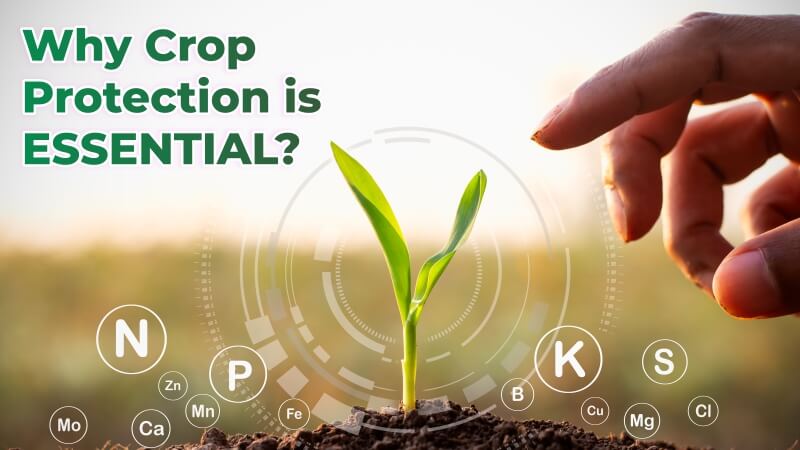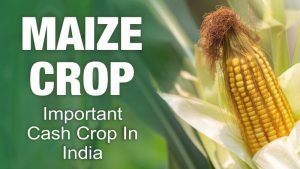Crop protection is a generic strategy or practice for defending crop yields against a variety of species, such as pests, weeds, plant diseases, and other creatures that harm agricultural crops.
In addition to weeds, small creatures like rats, mites, insects, vermin, disease-causing problems, and regularly attacked by birds, agricultural areas would also include crops. The loss or damage to the crops is primarily caused by all of these variables. Farmers must therefore safeguard their crops from these pests in order to produce large yields of crops. So, managing crop protection is crucial before, during, and after cultivation.
Importance of Crop Protection:
- In agricultural ecosystems, a single crop species is planted in a monoculture with hundreds or even vast numbers of individuals. We try to get rid of life forms that we consider to be pests in order to improve the growth of the optimal yield. Pests are living things that could compete with or harm crop species. They destroy berries, reduce plant thickness, impede plant growth and reproduction, lower the creation limit, and generally impair the yield or quality of horticulture products.
- Monitoring environmental factors, weeds, pests, and diseases that threaten or suppress the growth of natural products, vegetables, and other crops is known as “plant protection.”
- Effective plant protection is essential to achieving higher yields with little loss. Because of the increase in efficiency, growing food requires less land, water, and labor. Biodiversity is preserved, and fewer ozone-depleting pollutants are spread, as less land is used. Additionally, it makes sure more food is delivered in excellent condition to markets and stores, which helps keep prices low.
- There would be far less variety in the food available for purchase locally if we were to manage to stop using some of the more common assurance approaches with our soil-grown crops. Global yields would decline by about 33%. Only certain places would have quick access to the vegetables we have become accustomed to or have undervalued.
Methods of Crop Protection:
Farmers can use a variety of crop protection techniques and instruments to improve the success of their crops.
- Weed Control
Unwanted plants that grow alongside crops are known as weeds. These unwelcome plants rob the crops of nutrients, sunshine, water, and other resources and interfere with their growth, causing the crops to be undernourished and lowering yields. Farmers use a technique known as weeding to get rid of these weeds in order to protect the productivity of crops.
The act of controlling weed growth is known as weeding. There are several techniques for weeding:
- Using weedicides to spray on the weeds
- Weeds being manually pulled out by hand
- Weed removal using a trowel and harrow
- Before planting the seeds, cultivate the field to get rid of the weeds
- Management of Pests and Insects
Pests and insects together account for the majority of crop damage and production reduction. They might destroy the entire harvest and consume a substantial amount of grains. In fact, if they are not controlled, they can lower crop productivity by 30 to 50 percent annually. Integrated pest and insect management is the greatest strategy for preventing crop damage. By preventing insects and other pests from damaging crops, pesticides and insecticides are sprayed.
- Disease Management in Crops
Another category of variables that harm crops is pathogenic infections. Microorganisms like bacteria, fungus, and viruses have an impact on diverse crop sections in a variety of ways. Through the use of insecticides and biocontrol agents, crops could be shielded from these diseases.
Protection of the Crop Post Cultivation
The crop must now be picked as it has matured. The act of cutting and gathering a mature crop is referred to as harvesting. The immediate post-harvest activities like threshing and winnowing are also typically included in the term “harvesting.” Let’s examine both of these procedures.
Threshing: Threshing is the process of separating grains from their chaff or pods.
Winnowing: Winnowing is the process of separating the grains from the chaff after threshing. The method of separating the grains is called winnowing.
Before harvesting crops, there are several things to consider. To ensure that harvesting isn’t done too soon, the crops need to be carefully inspected.
To prevent product loss, a secure location should be identified to store the harvested grains. Compared to prior cultivation, the likelihood of grain loss is significantly higher at this stage. As a result, protection strategies need to be improved. The loss was caused by common bugs and rodents, as well as a few climatic factors including humidity and temperature. We can prevent this loss by taking certain safeguards. The grains should be thoroughly cleaned and dried in the sun before being stored since doing so helps to prevent the crops from fungal growth, which is brought on by moisture. Even killing pests is possible with a technique called fumigation.
Regulations and Registrations of the Government
The pesticide industry is unregulated. The nation produces enough technical pesticides and their formulations on its own for the most part. India exports pesticides on a net basis. The Insecticide Act of 1968, which is managed by the Department of Agriculture and Cooperation, Ministry of Agriculture, has laws that regulate the pesticides sector. The Central Insecticides Board and the Registration Committee are the departments’ organizations responsible for policing the production, distribution, use, export, and import of pesticides. State governments are in charge of enforcing the Insecticide Act. The Department of Chemicals and Petrochemicals serves as a catalyst for the industry’s expansion.
The manufacture, import, sale, transportation, distribution, and use of pesticides are governed by the Insecticide Act of 1968, which is handled by the Ministry of Agriculture’s Department of Agriculture and Cooperation (DAC), not the Department of Chemicals and Petrochemicals, in order to prevent risk to human health, animal health, and the environment.
The DAC also takes care of other crucial concerns pertaining to the pesticides sector, such as the prevention of the use of fake pesticides, quality standards, testing, reviews of pesticide use, and raising awareness of the prudent use of pesticides among farmers.
To get the latest updates on the tractor, tractor price, and tractor news install the KhetiGaadi application.




